Examination of Sediment Dynamics Based on the Distribution of Silica Fluxes and Flood Sediments in the Otoishi River Related to the Northern Kyushu Heavy Rain Disaster, July 2017
Abstract
:1. Introduction
2. Study Area
3. Field Survey and Observations of Dissolved Silica in the River
4. Results and Discussion
4.1. River Erosion and Flood Sediment Characteristics
4.2. Measurement of Sediment Thickness
4.3. River Flow and Dissolved Silica Concentration
4.4. The Relationship Between the Distribution of Collapsed Slopes and Silica Flux
5. Conclusions
Author Contributions
Funding
Acknowledgments
Conflicts of Interest
References
- Ministry of Land, Infrastructure and Transport. Summary of Sediment Disaster Caused by Heavy Rain in Northern Kyushu in July 2017. [Heisei 29 nen 7 gatsu Kyushu Hokubu Gouu ni yoru Dosha Saigai no Gaiyou]. 2017, Volume 6. Available online: http://www.mlit.go.jp/river/sabo/h29_kyushu_gouu/gaiyou.pdf (accessed on 20 October 2017).
- Kimura, I.; Kitazono, K. Studies on Driftwood Motions around Obstacles by Laboratory and Numerical Experiments. E3S Web Conf. 2018, 40, 02032. [Google Scholar] [CrossRef]
- Tateishi, R.; Horiguchi, T.; Ishikawa, N.; Shima, J.; Mizuyama, T.; Sonoda, Y. Experimental study on blockage of driftwood roots and sediment by steel open-type Sabo dam. J. Jpn. Soc. Eros. Control Eng. 2017, 70, 11–18. [Google Scholar]
- Chen, C.; Fujita, M. Simulation of sediment disasters due to slope failures and the following sediment runoff. Int. J. Eros. Control Eng. 2014, 7, 19–31. [Google Scholar] [CrossRef]
- Japan Meteorological Agency. Abnormal Weather Risk Map—Increasing of Heavy Rain. 2018. Available online: https://www.data.jma.go.jp/cpdinfo/riskmap/heavyrain.html (accessed on 5 November 2018).
- Pan, X.; Nakamura, H.; Nozaki, T.; Huang, X. A GIS-based landslide hazard assessment by multivariate analysis. J. Jpn. Landslide Soc. 2008, 45, 187–195. [Google Scholar] [CrossRef]
- Zhao, J. Study on the Evaluation System of Slope Stability Analysis Based on GIS and Its Application. Open Cybern. Syst. J. 2014, 1205–1210. [Google Scholar] [CrossRef]
- Holland, H.D. The Chemistry of the Atmosphere and Oceans; John Wiley & Sons Inc.: Hoboken, NJ, USA, 1978; p. 369. [Google Scholar]
- Maher, K.; Chamberlain, C.P. Hydrologic Regulation of Chemical Weathering and the Geologic Carbon Cycle. Science 2014, 343, 1502–1504. [Google Scholar] [CrossRef] [PubMed]
- Kennedy, V.C. Silica Variation in Stream Water with Time and Discharge in Nonequilibrium Systems in Natural Water Chemistry; Advances in Chemistry Series 106; American Chemistry Society: Washington, DC, USA, 1971; pp. 94–130. [Google Scholar]
- Perron, J.T.; Kirchner, J.W.; Dietrich, W.E. Formation of evenly spaced ridges and valleys. Nature 2009, 460, 502–505. [Google Scholar] [CrossRef]
- Ikemi, H.; Nakanishi, R.; Baba, A.; Okajima, Y.; Mitani, Y. Spatial Distribution of Collapse, Erosion, and Sedimentation in Otoishi River due to the Heavy Rain Disaster in the North Part of Kyushu, 2017 [Heisei 29 Nen Kyushu Hokubu Gouu Saigai ni yoru Otoishi Ryuuiki no Houkai, Shinshoku, Taiseki no Kuukan Bunpu]; Report on the Western District Division of Natural Disaster Research Council; Natural Disaster Research Council: Fukuoka, Japan, 2018; Volume 42, pp. 71–75. [Google Scholar]
- Azhikodan, G.; Yokoyama, K. Sediment transport and fluid mud layer formation in the macro-tidal Chikugo river estuary during a fortnightly tidal cycle, Estuarine. Coast. Shelf Sci. 2018, 202, 232–245. [Google Scholar] [CrossRef]
- Shoji, J.; Ohta, T.; Tanaka, M. Effects of river flow on larval growth and survival of Japanese seaperch Lateolabrax japonicus (Pisces) in the Chikugo River estuary, upper Ariake Bay. J. Fish Biol. 2006, 69, 1662–1674. [Google Scholar] [CrossRef]
- Owada, M.; Jikihara, S.; Osanai, Y.; Yamamoto, K. Low P/T metamorphic rocks from Sefuri Mountains and its correlation with low P/T type metamorphic rocks in Kyushu, southwest Japan. Mem. Geol. Soc. Jpn. 2000, 56, 229–240. [Google Scholar]
- Pachri, H.; Mitani, Y.; Ikemi, H.; Jiang, W. Spatial variation of soil depth and shallow slope failures in Sangun mountains, Fukuoka Prefecture, Japan. Int. J. Geosci. 2015, 6, 813–820. [Google Scholar] [CrossRef]
- Chorley, R.J.; Schumm, S.A.; Sugden, D.E. Geomorphology; Methuen & Co. Ltd.: London, UK, 1985; p. 605. [Google Scholar]
- Kyushu Active Structure Study Group. Active Structure in Kyushu [Kyushu no Katsukouzou]; University of Tokyo Press: Tokyo, Japan, 1989; p. 562. [Google Scholar]
- Yada, J.; Yano, K.; Yamamoto, S.; Hosoya, T. The Northern Kyushu Heavy Rain Disaster in July 2017, Possibility of the Geological Predisposition of Fault Fracture Zone and a Large Amount of Sediment Discharge Accompanying Otoishi Fault (Tentative Name) [Heisei 29 nen 7 gatsu Kyushu Hokubu Gouu Saigai Otoishi Dansou (Kashou) ni tomonau Dansou Hasaitai to taryou no Dosha Ryuushutsu no Chishitsuteki Soin no Kanousei]. 2017. Available online: http://www.jseg.or.jp/kyushu/#disasterreport (accessed on 6 December 2017).
- Kobayashi, H.; Takano, S.; Fukasawa, S. Determination of Silica in Hot Springs by Weight Method and Molybdosilicic Acid Yellow Spectrophotometry; Annual Report of the Yamanashi Institute for Public Health; Yamanashi Institute for Public Health: Yamanashi, Japan, 1994; Volume 38, pp. 1–4. [Google Scholar]
- Umezaki, Y. Simultaneous colorimetric theorem of silicic acid and phosphoric acid [Keisan oyobi Rinsan no Douji Hishoku Teiri]. J. Jpn. Chem. (Nihon Kagaku Zasshi) 1961, 82, 851–855. [Google Scholar]
- Henley, R.W.; Truesdell, A.H.; Barton, P.B.; Whitney, J.A., Jr. Reviews in Economic Geology. In Fluid-Mineral Equilibria in Hydrothermal Systems; Society of Economic Geologists: Littleton, CO, USA, 1984; Volume 1, p. 267. [Google Scholar]

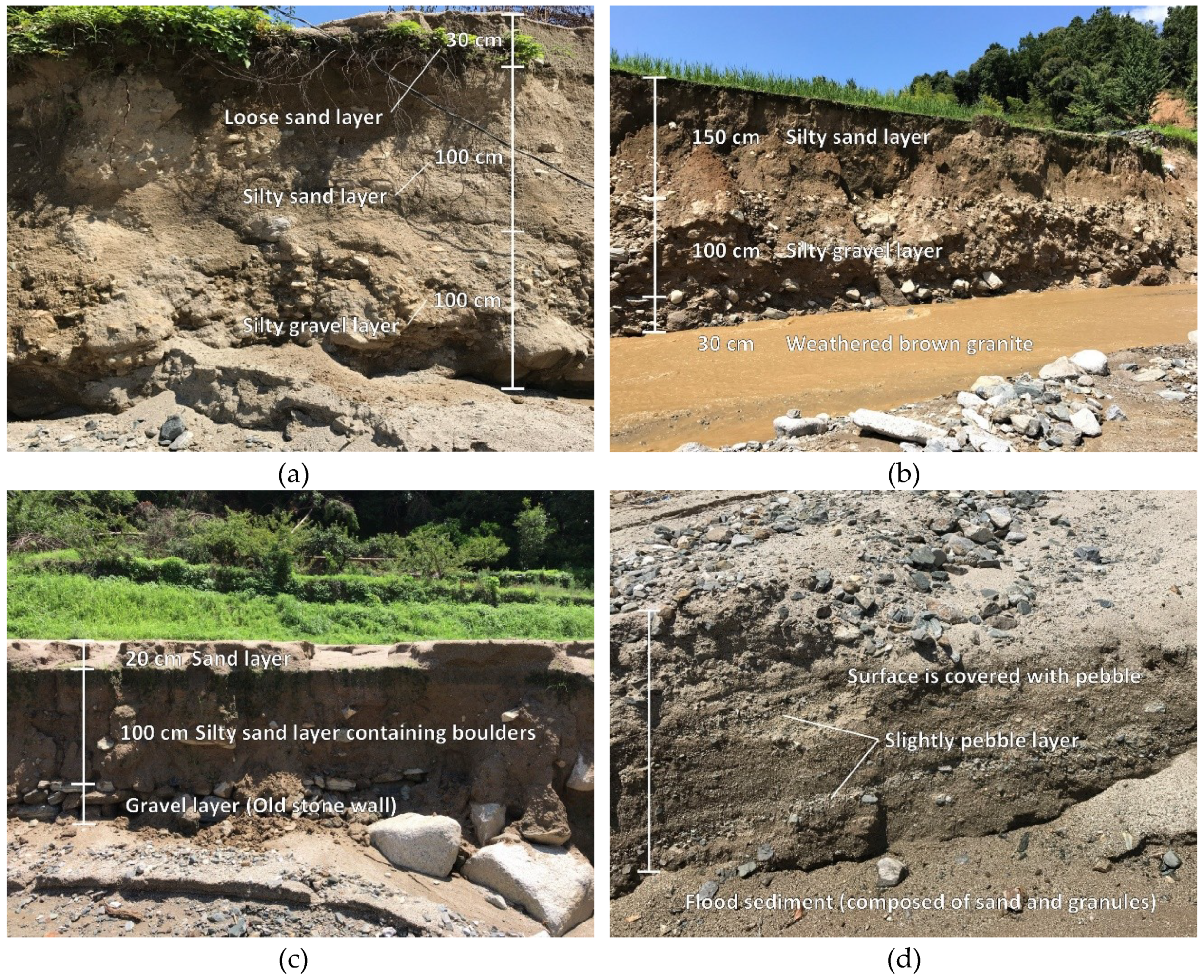
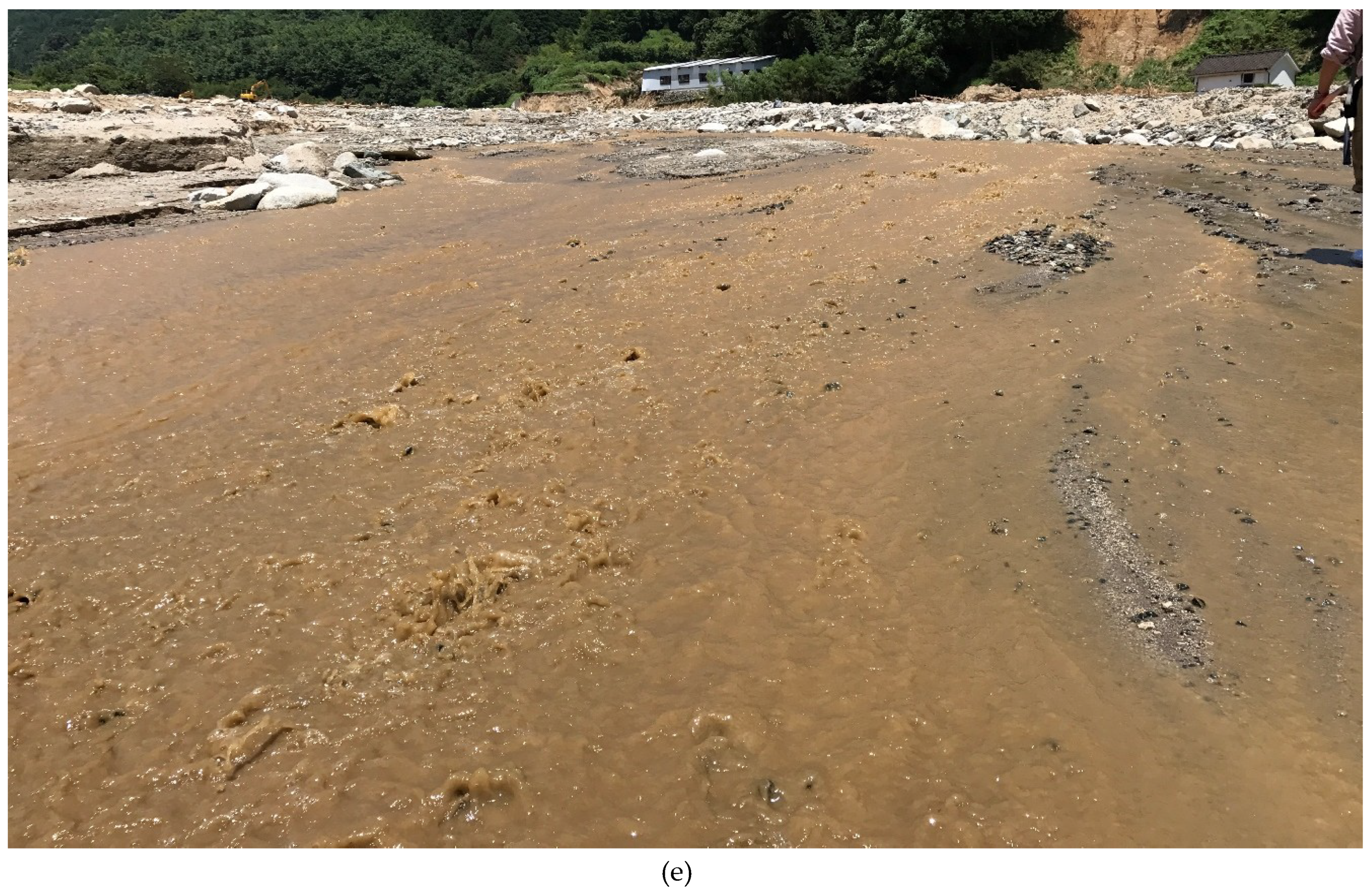
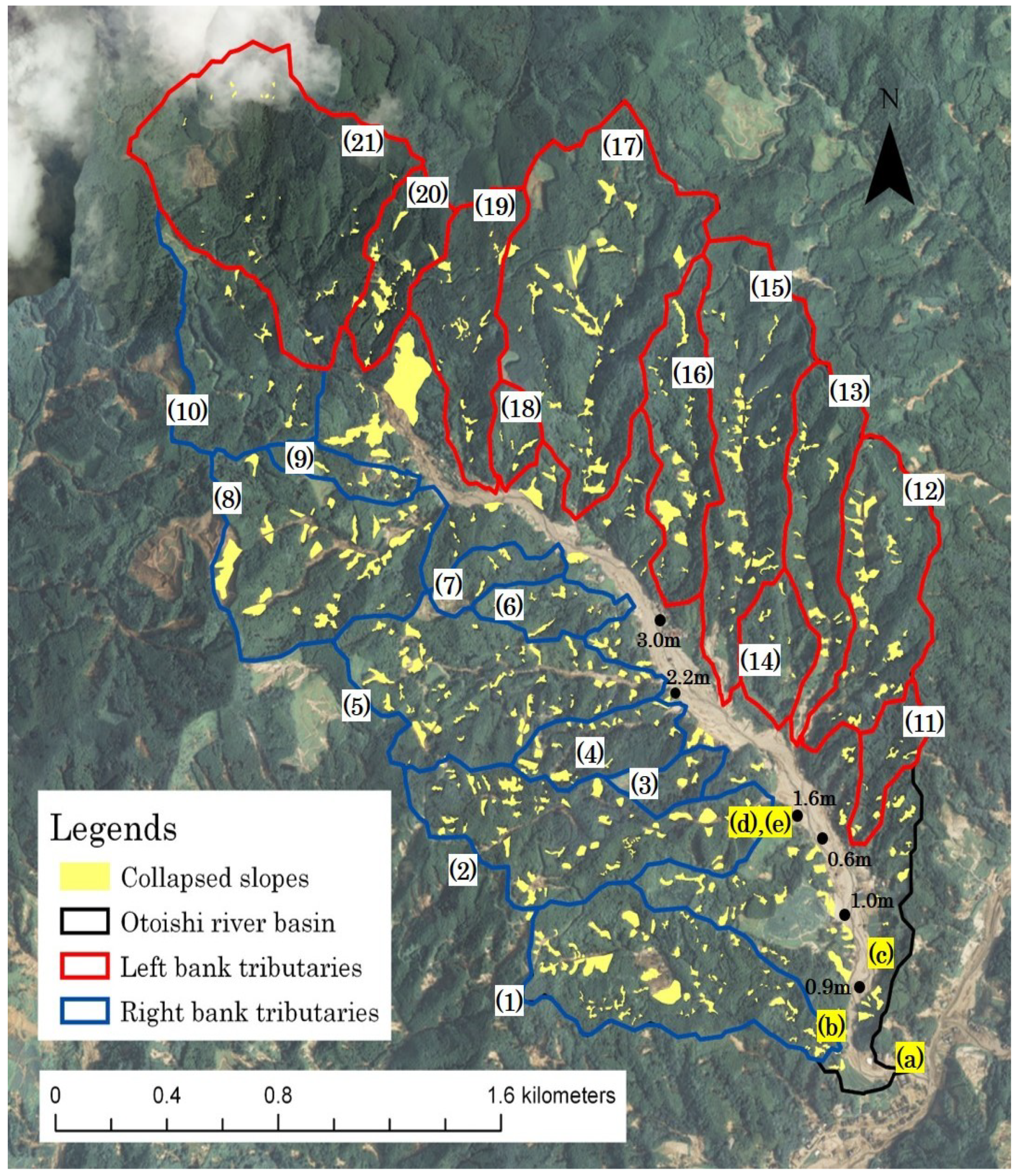
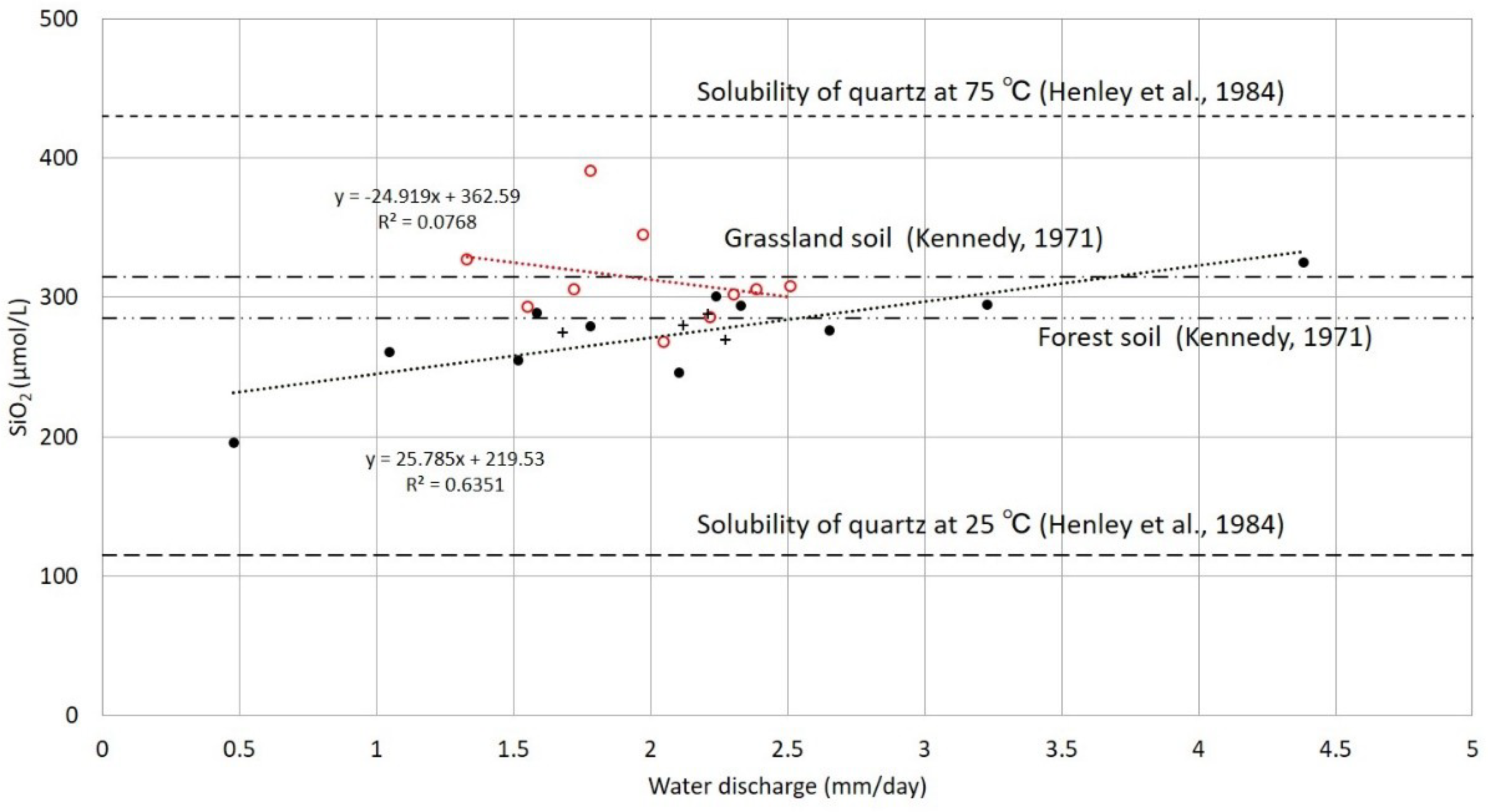
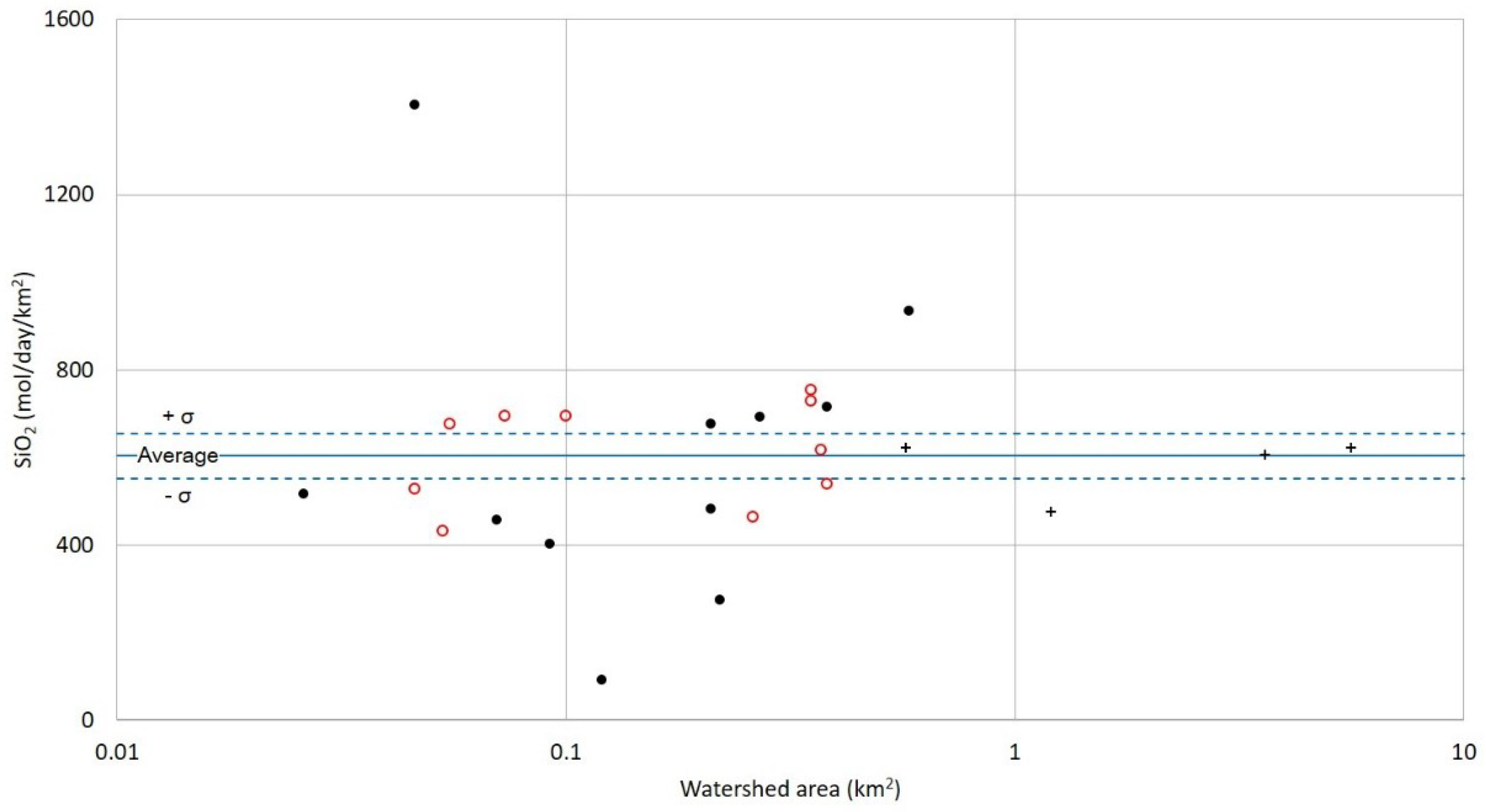
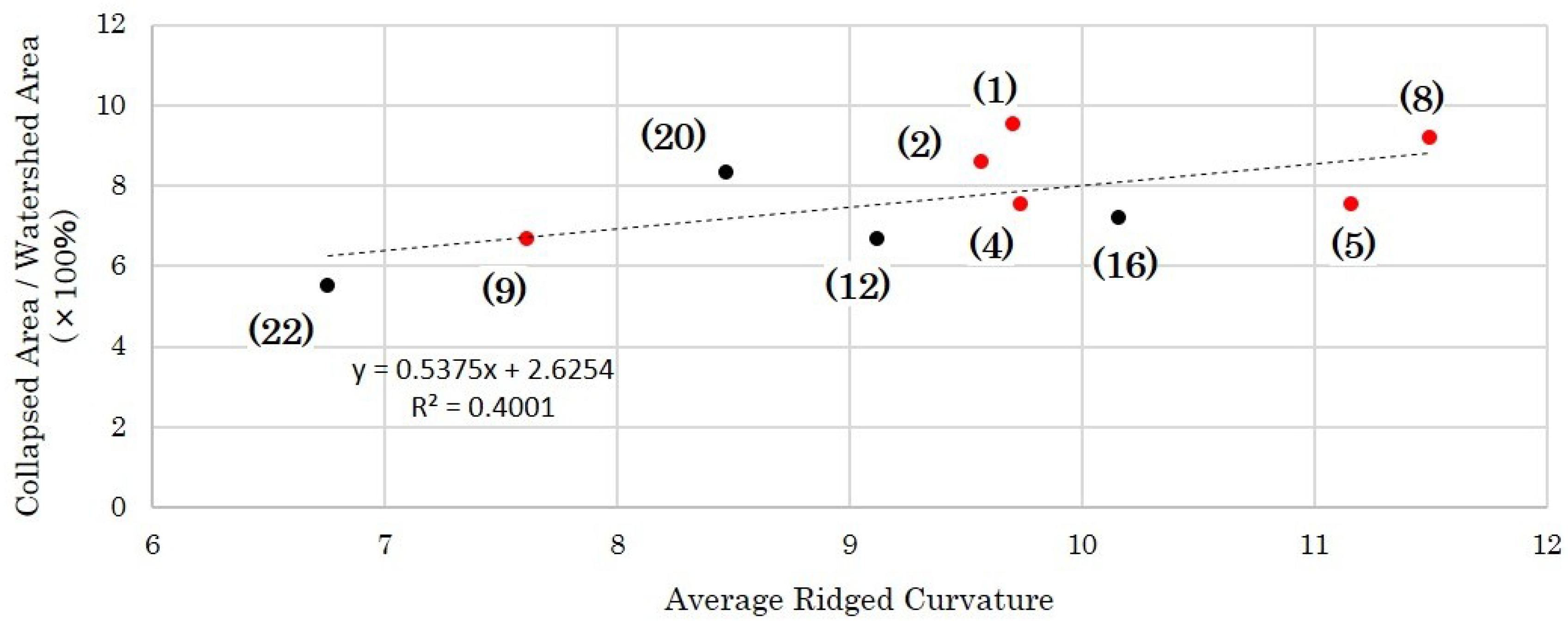
| Number | Watershed Area (m2) | Collapsed Area (m2) | Collapsed Area/Watershed Area (×100%) | Average Ridged Curvature | Average Slope Angle (Degree) |
|---|---|---|---|---|---|
| Right Bank Tributary | |||||
| 1 | 361,759 | 34,473 | 9.5 | 9.7 | 31.2 |
| 2 | 358,934 | 30,825 | 8.6 | 9.6 | 34.5 |
| 3 | 47,631 | 2220 | 4.7 | 9.0 | 33.0 |
| 4 | 113,829 | 8565 | 7.5 | 9.7 | 36.0 |
| 5 | 376,818 | 28,325 | 7.5 | 11.2 | 34.7 |
| 6 | 74,531 | 2920 | 3.9 | 10.2 | 32.1 |
| 7 | 57,422 | 1712 | 3.0 | 10.1 | 37.8 |
| 8 | 380,979 | 34,972 | 9.2 | 11.5 | 34.9 |
| 9 | 53,903 | 3589 | 6.7 | 7.6 | 28.7 |
| 10 | 250,285 | 3868 | 1.6 | 10.6 | 30.8 |
| 6.21 (Average) | 9.92 (Average) | 33.37 (Average) | |||
| Left Bank Tributary | |||||
| 11 | 68,879 | 2334 | 3.4 | 11.1 | 34.4 |
| 12 | 261,851 | 17,449 | 6.7 | 9.1 | 31.9 |
| 13 | 206,647 | 7680 | 3.7 | 8.7 | 33.5 |
| 14 | 93,964 | 1470 | 1.6 | 9.9 | 32.2 |
| 15 | 379,301 | 16,625 | 4.4 | 10.7 | 35.1 |
| 16 | 204,824 | 14,731 | 7.2 | 10.2 | 36.6 |
| 17 | 585,998 | 28,462 | 4.9 | 10.0 | 33.4 |
| 18 | 46,174 | 1581 | 3.4 | 10.2 | 37.6 |
| 19 | 210,618 | 7521 | 3.6 | 9.0 | 29.9 |
| 20 | 121,591 | 10,111 | 8.3 | 8.5 | 28.9 |
| 21 | 575,629 | 5090 | 0.9 | 9.4 | 30.7 |
| 4.36 (Average) | 9.71 (Average) | 33.10 (Average) | |||
© 2019 by the authors. Licensee MDPI, Basel, Switzerland. This article is an open access article distributed under the terms and conditions of the Creative Commons Attribution (CC BY) license (http://creativecommons.org/licenses/by/4.0/).
Share and Cite
Nakanishi, R.; Baba, A.; Tsuyama, T.; Ikemi, H.; Mitani, Y. Examination of Sediment Dynamics Based on the Distribution of Silica Fluxes and Flood Sediments in the Otoishi River Related to the Northern Kyushu Heavy Rain Disaster, July 2017. Geosciences 2019, 9, 75. https://doi.org/10.3390/geosciences9020075
Nakanishi R, Baba A, Tsuyama T, Ikemi H, Mitani Y. Examination of Sediment Dynamics Based on the Distribution of Silica Fluxes and Flood Sediments in the Otoishi River Related to the Northern Kyushu Heavy Rain Disaster, July 2017. Geosciences. 2019; 9(2):75. https://doi.org/10.3390/geosciences9020075
Chicago/Turabian StyleNakanishi, Ryunosuke, Akira Baba, Takahiro Tsuyama, Hiro Ikemi, and Yasuhiro Mitani. 2019. "Examination of Sediment Dynamics Based on the Distribution of Silica Fluxes and Flood Sediments in the Otoishi River Related to the Northern Kyushu Heavy Rain Disaster, July 2017" Geosciences 9, no. 2: 75. https://doi.org/10.3390/geosciences9020075
APA StyleNakanishi, R., Baba, A., Tsuyama, T., Ikemi, H., & Mitani, Y. (2019). Examination of Sediment Dynamics Based on the Distribution of Silica Fluxes and Flood Sediments in the Otoishi River Related to the Northern Kyushu Heavy Rain Disaster, July 2017. Geosciences, 9(2), 75. https://doi.org/10.3390/geosciences9020075




